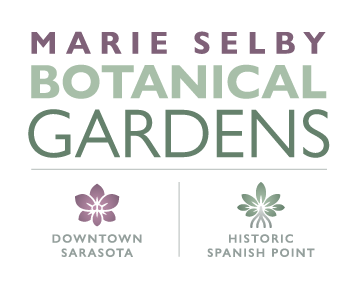Marie Selby Botanical Gardens (Selby Gardens) is collaborating with the New York Botanical Garden, Chicago Botanic Garden, Denver Botanic Garden, and Desert Botanical Garden to expand New York Botanical Garden’s pioneering EcoFlora Project. A grant from the Institute of Museum and Library Services will provide a portion of the funding necessary for Selby Gardens to participate in the multi-year project. The goal of the EcoFlora Project is to enlist the help of citizens in documenting the diversity and distribution of plants in their respective geographic areas. The Sarasota- Manatee EcoFlora Project is dedicated to the flora of Sarasota and Manatee Counties, Florida, USA.
Southwest Florida is home to a significant diversity of plants, animals, fungi, and habitats that provide such vital ecosystem services as cleaning the air and filtering the water. This biodiversity, though, is under increasing threat by development, invasive species, and a changing climate. The local community will get to play a role in this effort through a platform that EcoFlora Project is using called iNaturalist.
“We are thrilled to be selected as part of this project,” says Jennifer Rominiecki, president & CEO of Selby Gardens. “This is a perfect way to explore the nature in your own backyard during these unprecedented times resulting from COVID-19. It also allows us to further our mission to connect people to nature. We hope that this provides our community with an opportunity to not only learn about nature, but to feel as though they are helping to understand and conserve plant life on earth.”
“What is wonderful about this project is that it will engage citizens from adolescents to retirees who love to be in nature and want to know what plants are called and where they grow,” says Bruce Holst, vice president for botany at Selby Gardens. “During these times, we encourage citizens to explore their backyards and submit their findings to the project. It is a wonderful learning opportunity.”
Selby Gardens hired two part-time staff members, Lisa Dailey and Sean Patten, to reach out to the community about the project and teach them how to use the iNaturalist platform. The Gardens will organize “EcoQuests,” or challenges to encourage people to hunt for a particular genus or species and conduct “bioblitzes” where staff will work with citizens to document as much as possible in a particular natural area, especially plants.
“It will be another avenue through which we can work toward creating comfort in nature with our community partners,” says Jeannie Perales, Selby Gardens’ vice president for museum exhibits, learning, and engagement. “We hope that the iNaturalist app helps people realize that their handheld devices can be used as tools for engaging in the natural world around them.”
The grant will also be applied to a second project to map and identify epiphytes in the United States and Canada. It will require the help of more advanced amateur naturalists, since epiphytes are often found high in tree canopies. When the first-ever map of vascular epiphyte distribution in the United States is completed, it will help show how climate change may be affecting these plant species. “Understanding where a plant grows in Sarasota or Manatee County—or anywhere on Earth—is critical for informed and effective conservation,” says Holst. “And having a general population that knows about and learns to appreciate nature can create a more powerful force to promote conservation ideals.”
